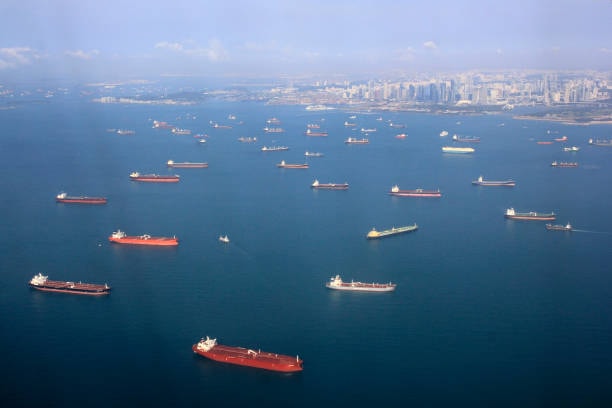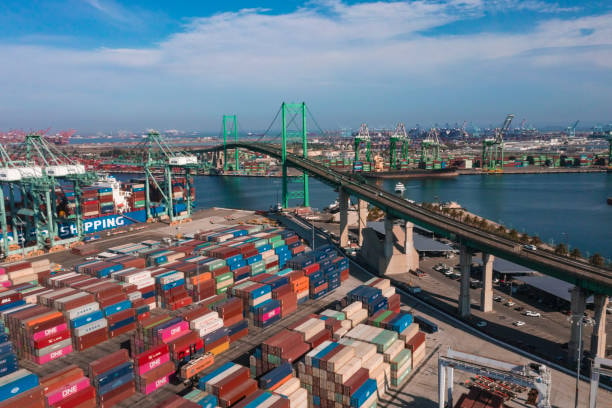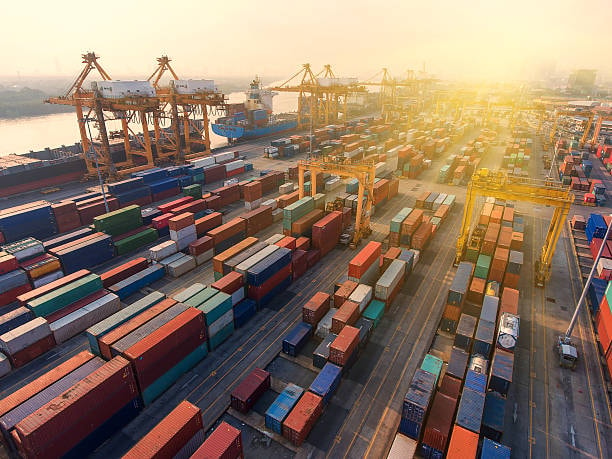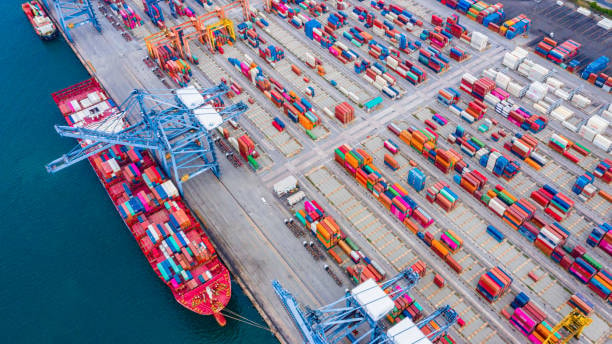
The Chinese export to the United States is an important part of the global trade touching millions of companies and customers every day. Knowledge of shipping lead times assist the importers in inventory planning, understanding the customer expectations, and streamlining the processes along the supply chain. The time of shipping between China and the US depends on several aspects such as mode of shipping, clearance, seasons of high importation and the availability of logistical activities around the world.
GWT Worldwide is a professional logistics service provider that offers global freight forwarding, supply chain and cross-border e-commerce logistics services at Shenzhen Guanwutong International Freight Forwarding Co., Ltd. We have a prime industry presence in China and international locations to provide quality, cost-efficient and solution-oriented logistics services to corporates worldwide with air freight, sea freight, China-Europe railway transport, international express offerings, customs clearance service, warehousing, and services to Amazon FBA shipment.
Understanding China to US Shipping Methods

Your mode of shipping is basically what determines the average shipping time between China and the United States. There are trade-offs in speed, cost and reliability with each form of transport. Vận chuyển nhanh has the benefit of getting packages within 3-7 business days though it is very expensive as compared to standard ones. Air freight is 5-10 business days in general and strikes the optimal balance between speed and fair cost on medium-sized shipments. The slowest mode, which is the most economical one, is sea freight, which takes 15-45 days depending on port congestion as well as specific route. The very cost effective method is ground transportation via rail networks which takes 18- 25 days and is somewhere in the middle between air shipping and sea shipping in terms of cost.
Express Shipping Timeframes from China

The quickest options available in transporting goods and products into the US in the wake of the goods being shipped or transported in between China to the US are the express shipping services which include DHL, FedEx, UPS and EMS. These services are usually premium that one can get their package in 2-5 business days during normal times. Commonly, DHL Express delivers within 2-4 working days hence it is only suitable where speed is a primary concern. FedEx International Priority offers delivery within 1-3 business days, however, such a high-quality service is associated with increased prices. Worldwide Express Saver offered by UPS normally takes 1-3 business days unlike the regular Worldwide Express that takes 1-2 business days. China Post EMS is a cheaper alternative to express with an approximate delivery time to the leading US cities in 3-7 business days.
Air Freight Shipping Duration

Air freight is a market popular alternative between slow cargo and express services, considering the freight cost . The average time of shipping standard air freight through China to the US is 5-10 business days with customs clearance and the delivery of the product to the final destinations by ground. The precise flying time between the major cities in China namely Shanghai, Beijing or Shenzhen to the hubs in the US including Los Angeles, New York or Chicago are 11-16 hours. Nonetheless, the overall shipping time encompasses ground handling, custom handlings and the final deliveries. Consolidated air freight involves that the duration of your shipment may be slightly longer as your cargo would be combined with other cargoes to cost-effectively and efficiently.
Sea Freight Shipping Times

The ocean freight is the most economical method of transport to large consignments, but takes relatively much time compared to other modes of transport by air. The transportation of cargo sent in ships to the US West coast takes 15-25 days in contrast to the east coast, which involves 25-35 days. Pacific shipping route towards the Los Angeles, Long Beach, Seattle and Oakland ports is shorter and there is a direct way compared with East Coast ports like New York, Savannah, Norfolk and Charleston. The ports of East Coast are accessible to the container ships either by passing through Panama Canal or by going around South America, which greatly increases the time it takes to reach them. These time frames can be added with up to several days or even weeks by port clogs, weather condition, and season related demand variations.
Factors Affecting China to US Shipping Speed

There are various factors that affect the timing of shipments in China to the United States, which is why, shipping schedules tend to be inconsistent. Customs clearance Most cargoes can take 1-5 days before they can actually arrive to their destinations depending on the cleanliness of the documents (Customs clearance), whether their goods need to be inspected by custom or not and the level of processing required by the Customs Clearance. Seasonal seasonal surge due to high shopping season such as Black Friday, Christmas trends and Chinese New Year may result in massive delays to all methods of shipping. Transportation may also be derailed because of weather conditions especially typhoons in Asia and winter storms in North America. Congestion in large ports such as at Los Angeles, Long Beach and Shanghai might build a bottleneck to thousands of shipments. Customs holds may span days and weeks due to documentation mistakes, loss of paperwork or compliance foundations.
Peak Season Shipping Delays
Peak periods in shipping greatly affect the delivery periods between China and the US with some taking very long delays at the initial stages of transportation regardless of the method used. Between the month of September to December is the busiest shipping season as retailers stock up ready to make sales around the holidays. The Chinese New Year, which usually falls between January and February, presents special difficulties since the factories are closed during 1-2 weeks resulting in backlogged shipments. Production and shipping can also be affected by the Golden Week in October in China. On these peak seasons, instead of the usual 2-5 days it can take express shipping to arrive within 5-10 days and between 20-35 days is the average time frame on normal occasions whereas sea freight can take between 40-60 days. Air freight capacity gets tight and costly, which could almost double the expenses of shipping and prolong the period of delivery.
Customs Clearance Impact on Delivery Times

The US Customs and Border Protection (CBP) is critical in the establishment of the final delivery schedules to the shipments coming out of China. Clearing of standard customs usually costs 1-3 business days on average on routine shipments that have supporting documents. Nevertheless, there are situations, which can protract this process a long way, requiring the expertise of a customs broker . Shipments of high value may undergo long processing time (5-10 days longer) and even those packages that are under further regulations or those whose packages have been selected to undergo physical inspection might take long (up to 5-10 days ). The products that are regulated by FDA, electronic products that must meet certain FCC regulations and textiles that must follow certain standard labeling usually take longer to clear. Processing the ACE system automates the process of many shipments, yet manual inspection of flagged goods and existence of non-fulfilled documentation take place.
Documentation Requirements Affecting Speed
The correct documentation will be required to easily go through the customs clearance and prevent the undo delay in shipping in China to US. The commercial invoices should have the right value of shipment, description of the products, and the harmony tariff classification numbers in the shipment. Descriptions of the quantities, weights and sizes of items should be in packing lists. Bills of ladings or airway bills are transportation contract and delivery directions. To receive preferential trade treatment, some products may be obliged to live up to certificates of origin. Regulated goods such as food, pharmaceuticals or telecommunications equipment require an import license or import permit. Insufficient, incorrect or unavailable documentation may lead to several days-weeks of custom holdings, greatly adding to the duration of the shipping process.
Port Congestion and Infrastructure Delays
The presence of port congestion is one of the significant contributors to the time taken to ship goods that move out of China and into the United States especially goods that are transported through sea transportation. When the ports of Los Angeles and Long Beach are congested, about 40 percent of container imports in the US go through these ports which means that they are serious points of bottlenecks. When operating under weather conditions of peak period or labour dispute, the vessels could be waiting up to 5-15 days before shipping cargo. Ports in China such as Shanghai, Shenzhen, and Ningbo are also congested and this may cause delays in the schedules. Ground-side delays are brought about by infrastructure constraints such as shortage of crane capacity, shortage of truck chassis and unsatisfactory rail capacity. After decongestion of containers, more time is taken during the stage of customs clearance, inland transport, and the delivery of bumpers to the consignees.
Regional Variations in US Delivery Times

Transit shipping time to United States through China depends on the final destination in the USA, and differs greatly. Locations on the West Coast are usually supplied quicker because of a shorter Pacific shipping distance and their near large ports. Most cities such as Los Angeles, San Francisco, Seattle and Las Vegas are frequently supplied by sea freight within 15-20 days as well as air freight within 3-7 days. Destination points on the East Coast will take more time in transportation and cities such as New York, Boston, Miami and Atlanta are likely to receive their freight within 25-35 days by sea. Chicago, Detroit, and Minneapolis in Midwest will stand somewhere in the middle as it depends on which coast would goods arrive by. West Coast or East Coast, affecting both the buyer and seller involved in the shipping process . Smaller cities and rural destinations can take extra 2-5 days to deliver the last product when compared to large metros.
Shipping Method Comparison and Selection
The cost, speed, and characteristics of the shipment are the factors that should be considered when it comes to choosing the right method of shipping. Express shipping is the fastest, with the highest premium price and therefore appropriate when there is an urgent shipment and/or it is of high value and / or time sensitive. Air freight gives favorable speed to cost ratio with medium-weight shipments that are too slow to channel via sea freight and are too risky to use express shipping. Sea freight is the most economical mode of freight transportation and is used in cases involving very heavy or bulky cargo whose transportation requires a long delivery period and the cargo is not urgent. Couriers have từ cửa này đến cửa khác convenience and tracking with insurance but are more expensive per-pound. The most ideal decision is the one based on the size, value, urgency and budget limit of the shipment, which can help reduce shipping costs . A great number of companies employ an integrated approach to shipping in order to streamline the supply chain results.
E-commerce Shipping Considerations
The shipping of the products, originating in China and going to customers in the US, presents a unique opportunity and challenge to the e-commerce business because a keen attention is payable to the customers expectation and time lines or durations involved. The usual timeframe of receiving standard e-commerce tracked packages is 7-21 days, depending on the level of the chosen service. ePacket service, its analog, used for small online shops deliveries normally takes 7-14 business days with tracking. Third-party logistics providers and fulfillment centers have become common in many of the e-commerce stores, and among different sellers in order to minimize shipping times and enhance customer satisfaction. Amazon FBA (Fulfillment by Amazon) programs have permitted Chinese sellers to stock products in warehouses in the US where they ship products to the buyers within 1-2 days to prime members. Whether to ship directly out of China or to use a fulfillment center in the US has big implications on the speed of delivery and customer experience.
Seasonal Weather Impact on Shipping
The fact is that weather conditions greatly impact shipping periods between China to the United States across the year. Hurricane weather in the Western Pacific, which occurs mostly during May- November, has the ability to derail shipping routines, and close Chinese ports. The climate of the two countries during winters may alter ground transport and interfere with aviation actions at airports over the pacific ocean . Spring represents relatively stable weather, which makes it a perfect time to organize stable shipping. Heat during the summer can be a problem with some temperature-sensitive freight and can lead to brief congestion in the ground transport. The period of June through November hurricane season on the US East Coast may affect port activity and inland transport. Delays related to weather are usually rather unpredictable and can increase the normal shipping time by 1-7 days in general.
Technology and Tracking Systems
The contemporary level of logistics technology has enhanced visibility and predictability of the China-US shipping schedules to a considerable extent. Real time tracking and monitoring systems enable consignees and shippers to view the status of shipment as the transport progress is undertaken. Specific location detail can be placed on trucks with GPS tracking, containers with RFID tags, and vessels harnessed with satellite navigation. Automated messages warn the stakeholders about delays, clearance status, and delivery appointments. EDI systems facilitate processing of documentation and minimize error in handling paperwork. Machine learning algorithms and artificial intelligence predict delivery more accurately depending upon the previous history and situation. Such technological innovations facilitate more scheduled preparation and delivery forecast of the China to the US shipment.
Cost vs Speed Trade-offs
There is an inversely proportional relationship that exists between cost of shipping to China and delivery speed to the US meaning that particular attention must be given to business priorities. The cost of express shipping may be 5-10 times more than the cost of sea freight yet delivers in days instead of weeks. Comparisons of air freight and sea freight denote that air freight is between 2 to 4 times expensive but is equally however provides a moderate speed enhancement. This cost difference increases with the heaviness of shipments as the cost advantage of sea freight has been much more. Even inexpensive items like seasonal goods, or carpet or appliance replacement parts, can be shipped on express delivery at premium costs. Sea freight may be cheaper especially on prolonged delivery of bulky goods that are not urgent. Various types of shipping companies and the shipment of various types of product categories of different values, urgency, etc. are utilized by many businesses as their tool of supply chain optimization.
Customs Duties and Processing Times
Customs duties/requirements of cleanup in the USA go directly to shipping timeframes in China. The items under extra tariffs could need the more thorough examination and verification of documents. Anti-dumping charges of some of the Chinese products can activate prolonged supervision procedures. Section 301 tariffs of Chinese imports have the possibility to need further compliance checks. De minimis shipments which are duty-free (as opposed to dutiable shipments) often have an easier time clearing customs due to the speed at which they go through it. Customs processing may also be accelerated by using trusted trader programs such as C-TPAT(Customs-Trade Partnership Against Terrorism) by eligible importers. Calculation of duties and requirements are also more complicated per product category and can add an extra 1-5 days to the regularly required customs clearance times.
Supply Chain Disruption Factors
Interference in the global supply chain may greatly increase the shipping period between China and the US past the expected period. Strikes or other factors like the case of a port shutdown can stop operations and produce huge backlogs lasting days or weeks. The measures associated with the pandemic have shown how fast the global logistics may be broken. Geopolitical issues among nations may send a country to an even wider inspection and in the queue of processing. Possible port shutdowns due to natural disasters like earthquake, flood etc can make some ports or transportation routes temporarily non-operational. The variation in the fuel prices has impact on the costs of transportations and can affect the routing. The inability to meet capacity demands during the peak periods may result in the diversion of shipments to other sub-optimal routes with longer transit times.
Freight Forwarder Role in Timing
The professional freight forwarders are extremely important in streamlining the process of shipping goods between China and the US due to their experience and the connections that they command. Equity forwarders are familiar with the most effective routes and can suggest the best forms of shipping depending on the needs. They are the relationships with several carriers, so they can obtain better rates and service levels. Freight forwarders also engage in complex documentation requirements and in case there is a risk of customs delay because of errors in documentation. They offer pooled shipping service which can enhance transit of smaller shipments. Advanced forwarders through value added services include customs clearance, warehousing and destination delivery packages. The vast experience and knowledge of their territories can guide one to regulatory requirements and negate the common minor problems that delay most projects.
Amazon FBA Shipping Timeframes
The shipping of Amazon FBA (Fulfillment by Amazon) involves distinct aspects and deadlines that sellers with this platform have to consider in China. Sea freight transportation usually costs 15-25 days and air freight transportation takes between 5 and 10 days. Amazon has certain labeling, pack and documents to be filled as per the requirements prior to the delivery. These needs can be serviced through FBA prep in China at the cost of 2-5 days of processing time added to it. After goods reach the Amazon warehouses, they are receiving and processed within 1-7 days in order to be available in the sales. The distributed warehouse system of amazon could result in weakening the processing time because inventory can be stored in various fulfillment centers. A certain limit on seasonal capacity in times of peak could prolong the receiving time and even demand delivery of the time. Sea freight Time to Amazon usually takes 20-35 days to China factory whereas Air freights take an average of 10-20 days to the Amazon.
Small Package vs Large Cargo Differences
The time of shipping packages and large cargo between China and the US differs enormously as larger packages and cargo shipping take a different process and means of transportation. Anything less than 4.4 pounds (2kg) may still be sent, frequently at an affordable price and within a practical period of time, via postal services or by use of courier networks. Such light weights normally get through the custom by being processed with easier procedure. Transportation of massive loads involves greater logistics such as container booking, handling at the port and unique transportation equipment. There is a possibility that full container loads (FCL) can be transported quicker than less-than-container-load (LCL) shipments as the first ones do not involve consolidations and deconsolidation procedures. Special handling equipment, routing or delivery times may be needed handling heavy or oversize cargo. Such a long transit time is usually justified with large shipment economies of scale to provide a large saving on costs port to port.
Holiday and Peak Period Planning
Holiday and peak shipping periods are strategic planning necessities that should be utilized to ensure shipment of goods to China to the US is within reasonable delivery times shipment arrives. The Chinese New Year starts weeks ahead of time when the factories hurry along to meet their orders before the holiday closure. During this post-holiday season a lot of delays are experienced as factories get back into production and the back-logs on shipping are cleared. The holiday seasons in the US cause a surge in demand that overloads the transportation and extends the transportation time of all types of shipping. The anxiety to back to school make the late summer shipping volumes explode and may bring delays. Lengthy orders during the early period of time, elastic delivery time reduce peak period delays entire shipping process. Other companies move to air transportation in peak times to ensure that they meet their scheduled deliveries even though it comes at an increased cost. Alternative carrier relationships and spare shipping routes can be utilized in case the main channels get clogged timely delivery.
Quality Control Impact on Shipping Speed
Rigorous quality check processes might impact the total time of shipments between China and US greatly, but still are a typical parameter to ensure the customer satisfaction and compliance with products. Pre shipment checking is usually 1-3 days of extra processing time with the profit of returns and delays. These factory quality audits can slow down the first production but the long term reliability is enhanced. Regulation of pre-shipment processing of goods may add 5-15 days to the product testing and certification process of the regulated products full container load. Sometimes they will use the services of third-party inspection service which is an independent verification and needs extra coordination and scheduling. Rework or replacement may be necessitated by quality problems found out in the course of inspection which might take long to complete the deliveries. Other companies also have quality controller personnel within China to speed up inspection and minimize losing time. The money spent on quality control can be recouped when avoiding delays or repetition by the customs as well as reductions in returns and customer complaints china to the usa.
Insurance and Risk Management
Both the time and the cost of shipment between China and the US could be influenced through the shipping insurance and risk management factors. The extensive type of insurance coverage offers coverage against loss or damage but might consume other documentation and processing. Marine insurance covering sea freight consists of a number of coverage forms that might have an effect on routing and handling policies. Insurance in air cargo is usually more expensive compared to sea cargo insurance yet it covers at a faster rate. Processing claims on lost or damaged goods may be very lengthy and will add to the total delivery times. The risk management strategies involve diversification of shipping methods, carrier, and routes so as to eliminate the single point of failure. Shipping contracts endeavor to cover delay caused by a force majeure situation in the shipping contract. Risk assessment and mitigation planning is important in ensuring that supply chain reliability is not compromised even when disruption occurs express freight.
Future Trends in China-US Shipping
There are a number of new trends that have been altering shipping time and alternatives between China and the United States. Improvements in infrastructure by Belt and Road Initiative are opening new branches of transport and possibly shorten the shipping routes. Latest logistics technology, such as autonomous cars and flying drones, can potentially transform the pace of last-mile delivery. Blockchain technology will increase efficiency of documentation and custom clearance procedures leading to a reduction in administrative delays. Green shipping practices are urging a more viable form of transportation that can potentially influence the speed and route choice. Increased e-commerce expansion is associated with the growing need in quicker and flexible shipping. Modifications of US trade policies and bilateral arrangements with China may have great effect on shipping practices and duration sea and air freight. Automation and port infrastructure investment are slowly picking up with an efficiency in the processing and decreased congestion hold-ups.
Tracking and Communication Best Practices
The right track and communication arrangements are required to keep the expectations in control and shipping time in the best state feasible between China and US. The tracking information that is presented in real time assists to detect how the delays might occur and enable advance communication to a customer or stakeholders. Frequent checks on how the product is faring during the shipping process provide reassurance and minimize fears on when to expect the arrival of the product shipping cost. Keeping forewarned to understand the likelihood of delays during the peak season or unfavorable conditions helps meet the desired shipment date. There are also automated notification systems that notify parties involved with shipment milestones, customs clearance and delivery schedules. The interconnection of the tracking systems and the inventory control software makes supply chains easier to see and plan. Clear reporting of shipping options, charges, and timeline enables customers to make the right decisions on what matters to them freight costs.
Cost Optimization Strategies
To make shipping affordable without compromising delivery timelines, one should plan well and regularly verify the available transportation option between China and the US. Shipping lots of small packages can be bundled together to cut on shipping per unit cost and can possibly positively affect the time it takes to deliver. Volumes discounts with carriers or freight forwarders makes regular shippers save a lot of money. The flexibility of delivery schedule enables the shippers to benefit whenever the rate is cheaper ship cargo. The price performance tradeoff can be lessened by combining shipping methods based on different products categories. It is imperative to review shipping performance and costs on a regular basis in order to know where it can be improved. Inventory management systems can save unnecessary costly rushed shipments where the management investment has been done to improve forecasting and planning of the demand sea freight transit times.
Phần kết luận
The process of sending goods, especially between China and the United States, is quite complicated requiring juggling of the options of speed, cost, reliability, and service needs. Express shipping takes 2-7 days with a high premium rate whereas air freight takes 5-10 times at moderate prices and sea freight shipping takes 15-45 days at a low cost. There are several reasons such as the customs clearance cargo shipped, accuracy of documentation, seasonal demand, weather condition and congestion of port that can hugely affect estimated delivery schedule. Smart planning, documentation, and professional logistics partners make optimization of shipping performance and minimization of delays shipping company.


Thank you for reading!
Have questions, corrections, or better ideas? We’d love to hear from you!
We value every piece of feedback and promise to reply within 24 hours. Let's make this guide better together!
Note: Spam comments will not be published.